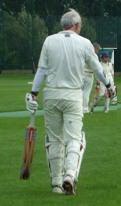But FB was born too late and the Heroic Age of Antarctic Exploration was well and truly over by the time he could tie the laces on his own snow shoes. His destiny was therefore frustrated. Nowadays there is a new age of scientific and high tech exploration and discovery and the Antarctic is on the verge of becoming a tourist destination. The age of exploration is a distant memory.
 |
| Amundsen's expedition at the South Pole |
Scott's anguish is clear from his diary: 'The worst has happened; All the day dreams must go; Great God! This is an awful place'. The party finally realised that their hopes were shattered. These quotes painfully demonstrate how they were finally forced to conclude that the possibility of cricket facilities being developed in the region were minimal.
 |
| Scott's party find no cricket facility at the S Pole |
Scott was originally celebrated as an iconic British hero, but his reputation suffered after the second world war when more critical assessments of the expedition identified poor planning and uncertain leadership. Revisions of this revisionist view are now less damning of Scott and some challenging external factors such as the weather have been identified. But, all in all, there still lingers something essentially British in the response to the heroic failure; to the apparent dignity of how these men met their fate; and to the fact that their bodies remain where they were found 10 months later. The bodies are now buried under many feet of snow and ice but, in a final irony, are moving steadily along the route that they were travelling as the geology changes – making the journey in death that could not be made in life.
Scott was not a cricketer, nor were any of his final companions. Would they have fared better had they been? JM Barrie the author of Peter Pan and other works, who had his own celebrity cricket team in the Edwardian period was a close friend of Scott’s and was the god father to his son Peter, later a TV naturalist and wildlife painter. So Scott will have had memories of gentle summer afternoons of cricket and tea to warm him as he lay in his final hours in the unremitting cold.
Some hardy souls are re-enacting the race between Scott and Amundsen. Their progress can be read on this link. So far it looks like Amundsen is in the lead again. And they are still unlikely to find cricket facilities in the region.


No comments:
Post a Comment